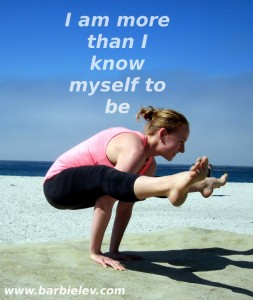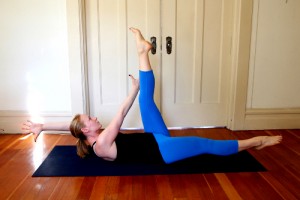After ten years teaching fitness and yoga and seven years studying Kinesiology and Cognitive Science I’m finally putting it all together: In January, I’m teaching Yoga EMPOWER Bootcamp at Thriveability in San Francisco. This four-week transformational series combines yoga and meditation with fitness and goal-setting to provide students safe, fun, and motivating, complete mental, physical, and spiritual workout. Here’s why I’m so hyped up about it:
Why Yoga?
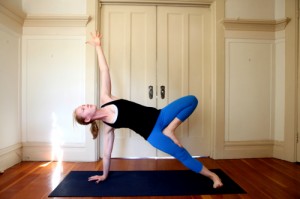
Side Plank with Tree (Photo Credit: Faye Chao)
Yoga is the foundation. It is the ultimate system for letting go of what no longer serves us, coming into acceptance of who we truly are, and realizing our divine purpose. Without the work we do in yoga (or other systems that guide us to develop in the same way), any action we take or goal we set is directionless and purposeless. The present moment awareness that yoga cultivates provides us a springboard from which we can take mindful, intentional action. Also, yoga helps us develop body awareness and flexibility, feels amazing, and is just plain fun.
Why Not Just Yoga?
As with any other type of paradigm that involves physical activity, there are common patterns of muscle imbalance that can arise when yoga is our only form of regimented movement (these imbalances often aren’t from the yoga, we come in with them and can reinforce them in yoga if we’re not careful). Even if we have yoga teachers who enforce alignment meticulously, it doesn’t mean we will rehabilitate these imbalances; often, it means we are discouraged from going into positions where our body shows signs of that imbalance. Yoga is not supposed to be about ego or goals, so we should be content with backing off and taking it easy, right? This is great for avoiding injuries on the mat, but it avoids problems rather than addressing them, so it allows us to retain imbalances that may lead to injury off the mat during our day-to-day movements.
It’s so amazing and healing to be able to think to yourself, it’s okay that I can’t do handstand. I’m perfect the way I am. But, without losing touch with that thought, it’s also worthwhile to question, why can’t I do handstand? Where am I losing the energy that is supposed to be holding me up? If the energetic bottleneck is something physical, it’s doesn’t really make sense to address it only with the spiritual practice of yoga (especially if you’ve been doing yoga for years and nothings changed). Drawing on the extensive knowledge of kinesiologists, exercise specialists, fitness instructors, and physical therapists would be much more directed and intentional.
Why Fitness?
Fitness helps us fill in the gaps of our yoga practice so we can maintain strong, healthy, functional, injury-free bodies. Developing body awareness, stability, strength, endurance, and power using fitness allows us to practice a broader range of poses safely. Often, the physically challenging poses offered as options in yoga classes will only ever be available to those who already have the fitness to do them (or who gain that fitness outside of yoga). Regular yoga classes often don’t provide the frequency, intensity, and type of movements to elicit the significant training effects needed to build the strength for a challenging pose like handstand.
For example, in yoga we do moderate-intensity core work as part of our warm-up or prep-work to bring awareness and circulation into the core and prime these vital muscles for the rest of class. It makes the core more able to contract properly in the short term. In fitness, we do high-intensity core work toward the end of class. The goal in this case is to fatigue the muscles, which is essential for improving strength and endurance over time. However, it makes the core less able to contract in the moment, which is why it’s safer to do at the end of class.
Personal Experience: After doing both yoga and fitness for years, I cancelled my gym membership and started doing vinyasa yoga almost exclusively. It only took a year of this for me to developed some painful imbalances and hypermobilities in my body that kept getting worse the more I practiced yoga. Everyone told me to stick to gentle classes, but the gentle poses made me feel worse than anything else. It wasn’t until I started doing Pilates and rehabilitative exercises that my body finally started recovering. Not only was I in less pain, as I strengthened my glutes, my hip flexibility increased instead of decreasing. Once my body was more stable it was safer for it to open up. As I strengthened my core to support my aching spine, a side effect was that poses that had never been accessible to me before started showing up. All of a sudden I could stick a handstand–if only for a couple seconds. I began to see poses like handstand not as an end goal, but as a check-in on stability, integrity, balance, and body awareness.
Doing fitness is not only about the physical benefits, there’s a philosophical aspect to it, too. It’s one thing to have a vision and a purpose, and even to clearly see your path (yoga and meditation are phenomenal forms of self-study that allow you to establish these things). It’s another thing to have the drive and know-how to follow the path toward your intention. In one of my college classes, we learned that will power is like a muscle: if you overuse it, it becomes burnt out; but if you practice it regularly without exhausting it, you’ll slowly build its strength and endurance. By adding fitness into our weekly practice, which–unlike yoga–is goal-oriented, we develop our tenacity, our determination, our perseverance, and our will. When we experience ourselves achieving our what we said we would achieve (especially if the goal was audacious), we begin to trust our own words, and our intentions become more powerful.
Why Inversions and Arm Balances?
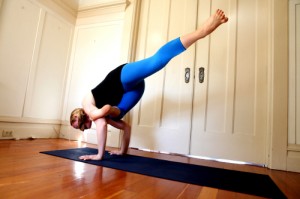
Eka Pada Galavasana (Photo Credit: Faye Chao)
1. They’re fun.
2. They are informative. If you wanted know where you tend to collapse in your body, do handstand and you’ll find out immediately. While many other poses whisper bits and pieces of feedback that are easy to miss, arm balances and, even more so, inversions give you a full presentation on a loudspeaker with PowerPoint slides.
3. They are empowering. The first time we see an inversion or an arm balance, our immediate reaction is, I can’t. But then (after a little work, perseverence, and guidance), it turns out we can, it helps us re-evaluate other possibilities in your life we’ve dismissed. Very few things are impossible. It just takes practice to identify and diligently follow the path to your wildest dreams.
Why So Often? Why so long? Why so early?
I want Yoga EMPOWER Bootcamp to remind you how powerful you and inspire you to tap into that power to achieve your divine purpose. The program is 5-days-a-week (Monday to Friday) at 6am for 4 weeks. To make radical changes in our lives, we must practice new habits regularly and for a sustained period. We alternate what we do everyday so we never end up with overworked or fatigued, and we take weekends off to we can recharge our will power and maintain balance in our lives. As with any program for improving fitness, it takes six weeks to see significant results, and I wouldn’t want you to miss out on experiencing what your capable of by cutting the program any shorter. However, for now, we’re offering a trial version of the program that’s only four weeks long, which is a little easier to commit to. Stay tuned for the full six-week version.
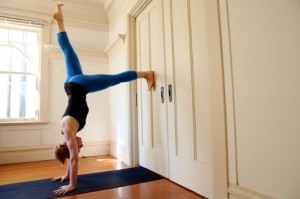
Down dog on the Wall with Leg Lift (Photo Credit: Faye Chao)
6am is earlier than most of us have anything planned, so there aren’t many excuses for not showing up. It’s hard to get up that early for six whole weeks, but each of us knows we’re capable of it–it’s another way we will develop will power. Also, when we’re waking up that early every day, we start to feel the effects of our lifestyles. They’re amplified. If we pay a even an iota of attention to our energy levels, it will become painfully apparent which lifestyle choices allow us to get out of bed and do an intense workout first thing in the morning, and which leave us running late, groggy, and unable to harness our power.
See you bright and early on January 6th at Thriveability!
I am so excited to share this program with you. I truly, wholeheartedly believe it will help you realize your purpose, develop the skills to achieve it, and learn some fun poses along the way.
